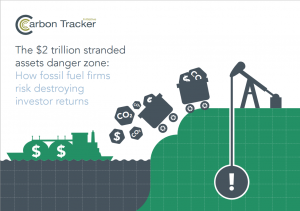Full Title: The $2 Trillion Stranded Assets Danger Zone: How Fossil Fuel Firms Risk Destroying Investor Returns
Author(s): Carbon Tracker Initiative
Publisher(s): Carbon Tracker Initiative
Publication Date: November 1, 2015
Full Text: Download Resource
Description (excerpt):
The low carbon express is coming” The data is clear – the energy transition is underway, and the direction of travel is away from fossil fuels. But not everyone will admit that the train has left the station, let alone that it is travelling faster than people expected and may skip some stations along the way.
Don’t get trapped in the danger zone: There is a clear danger zone above a 2°C scenario where excess capex and CO² emissions need to be avoided. All energy players have the chance to navigate around this by staying within the carbon budget. This will give the world an opportunity to reach the ultimate destination – a world that has prevented dangerous levels of climate change. Our analysis here focuses on the marginal production between the IEA 450 Scenario and business as usual for the coal, gas and oil sectors to 2035.
Carbon vs $capex: The table below summarises the overhang of unneeded capex (through 2025) and avoided CO² (through 2035) across the 3 fossil fuels in a 2°C-compliant 450 Scenario, compared to business as usual indicated in the industry databases. This makes the difference in financial and carbon significance clear. The greater scrutiny required for new projects is also obvious, accounting for 89% of unneeded capex and 67% of avoided CO². Over $2 trillion of capex needs to not be approved in order to avoid around 156 GtCO² of emissions – the equivalent of cutting supply and the subsequent emissions by around a quarter in the markets covered in this analysis. It is clear that oil represents around two-thirds of the financial risk but a fifth of the carbon risk, whilst coal carries around half of the carbon risk, but only a tenth of the financial risk. Gas is low in terms of the carbon risk, but still carries around a quarter of the financial risk.
